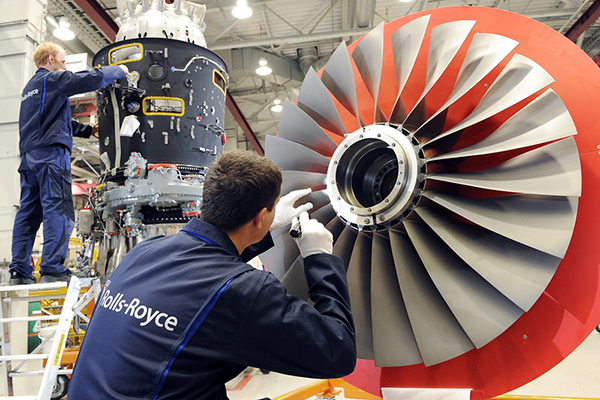Thinking behind Rolls-Royce price target downgrade
It’s the UK stock market’s best-performing stock of the past three years, but one City analyst is cooling expectations. City writer Graeme Evans explains why.
4th September 2025 13:10
by Graeme Evans from interactive investor

Credit: Rolls-Royce via Flickr.
A reduced Rolls-Royce Holdings (LSE:RR.) price target amid the prospect of a turn in the engine aftermarket cycle today tempered a City firm’s continued “high conviction” Buy stance.
UBS’ new estimate of 1,310p is still an upside of more than 20% on today’s level of 1,071p, but more cautious than the 1,375p it put in place after beat-and-raise interim results on 31 July.
- Invest with ii: Top UK Shares | How to Start Trading Stocks | Open a Trading Account
The move follows the bank’s decision to lower earnings forecasts by up to 2% as it moderates pricing and volume growth expectations in light of a revised view of the cycle.
It pointed out that engine aftermarket players including Rolls have seen strong sales growth since Covid, driven in large part by Airbus SE (EURONEXT:AIR) and Boeing Co (NYSE:BA) supply side challenges.
Now that aircraft production signals are improving, the bank questions when and how the cycle will turn. Its analysis of high frequency data suggests that upside remains in the current half and possibly into 2026, but with the risks building.
UBS said: “While Airbus and Boeing could benefit from the significant pent-up replacement demand for aircraft, the aftermarket cycle could turn as soon as 2026, we believe.”
It forecasts a return to mid-cycle aftermarket growth rates of about 6% by 2027-28.
- Why investors shouldn’t worry about weak stocks in September
- Trading Strategies: does Rolls-Royce still offer growth potential?
- ii view: income play L&G remains ‘firmly on track’
Against this backdrop, UBS downgraded MTU Aero to Neutral but said Rolls-Royce remained its most preferred name in the sector.
The bank first recommended buying the shares in March 2023, when they were at 153p, before making seven upgrades to its price target to stand at 1,375p.
In a note published last month, the bank outlined a “credible” scenario where shares hit £20.
This was based on the delivery of £5.8 billion of free cash flow in 2028, compared with the company’s current guidance between £4.2 billion and £4.5 billion.
The higher valuation was also built on the assumption that investors will increasingly move towards valuing Rolls-Royce against GE, given the more comparable ownership structure.
The bank’s updated base case is for £5.1 billion of free cash flow in 2028, which it believes sits at the low end of expectations based on investor estimates of £5.2 billion-£5.5 billion.
It said Rolls will not be immune to the cycle, particularly as a momentum trade.
However, it added: “Despite the risks associated with the potential turning of the aftermarket cycle we continue to have high conviction in the Rolls-Royce buy case.”
UBS believes that Rolls should be “somewhat less affected” by the turning of the cycle than peers, noting that about 60% of Rolls’ current flying hours are delivered on new generation engines compared with 40-50% for rivals Safran SA (EURONEXT:SAF), MTU Aero Engines AG (XETRA:MTX) and GE.
In the last six months, the bank added that Rolls engine flying hours have grown by about 7% against 5% for most peers. A higher share of new deliveries than the installed base should allow for faster volume growth through the cycle.
It believes the supply side cycle has been predominantly driven by shortages of narrow body aircraft, whereas Rolls is primarily exposed to wide body engines.
UBS adds: “Our central argument on Rolls-Royce is associated with a cultural change brought about by new management that allows for better pricing and cost efficiency across the group.”
- Stockwatch: does AI justify this cyclical share’s growth rating?
- Oil sector top picks: what the City thinks of Shell and BP
- Sign up to our free newsletter for investment ideas, latest news and award-winning analysis
The company’s results in late July included a 43% beat on half-year earnings and improved guidance for 2025, which further de-risked progress towards 2028 targets including an operating profit of £3.6 billion-£3.9 billion.
Rolls-Royce chief executive Tufan Erginbilgic, who has overseen a 10-fold increase in share price since taking over in January 2023, later told the BBC that the group has the “potential” to become the UK’s highest-valued company.
His optimism has been built around the company’s role in powering the data centres behind the adoption of artificial intelligence (AI). Erginbilgic estimates that the world will need 400 small modular nuclear reactors (SMRs) by 2050, a market he wants and expects Rolls to dominate.
Rolls is due to pay a dividend of 4.5p a share on 18 September, having recently resumed distributions with a full-year award of 6p a share.
The group is part way through a £1 billion share buyback programme, meaning the amount set to be returned to shareholders in 2025 will total £1.9 billion.
These articles are provided for information purposes only. Occasionally, an opinion about whether to buy or sell a specific investment may be provided by third parties. The content is not intended to be a personal recommendation to buy or sell any financial instrument or product, or to adopt any investment strategy as it is not provided based on an assessment of your investing knowledge and experience, your financial situation or your investment objectives. The value of your investments, and the income derived from them, may go down as well as up. You may not get back all the money that you invest. The investments referred to in this article may not be suitable for all investors, and if in doubt, an investor should seek advice from a qualified investment adviser.
Full performance can be found on the company or index summary page on the interactive investor website. Simply click on the company's or index name highlighted in the article.